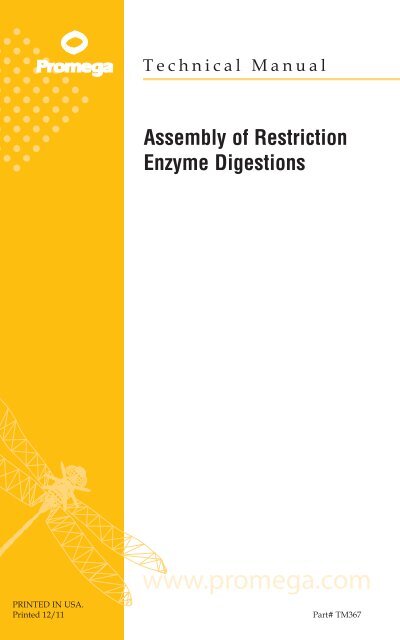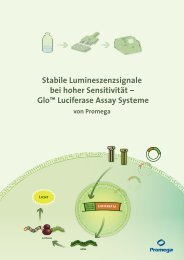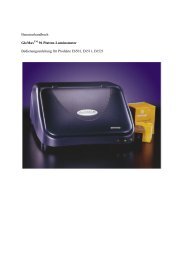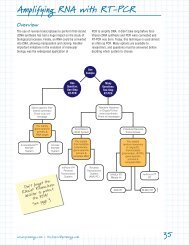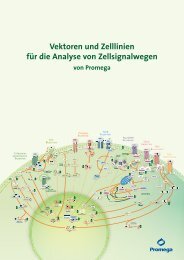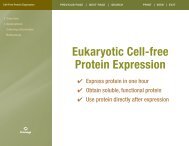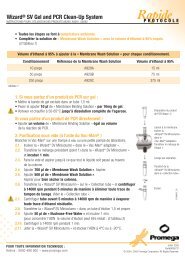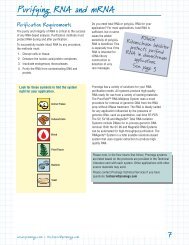Assembly of Restriction Enzyme Digestions - Promega
Assembly of Restriction Enzyme Digestions - Promega
Assembly of Restriction Enzyme Digestions - Promega
You also want an ePaper? Increase the reach of your titles
YUMPU automatically turns print PDFs into web optimized ePapers that Google loves.
Technical Manual<br />
<strong>Assembly</strong> <strong>of</strong> <strong>Restriction</strong><br />
<strong>Enzyme</strong> <strong>Digestions</strong><br />
PRINTED IN USA.<br />
Printed 12/11 Part# TM367
<strong>Assembly</strong> <strong>of</strong><br />
<strong>Restriction</strong> <strong>Enzyme</strong> <strong>Digestions</strong><br />
All technical literature is available on the Internet at www.promega.com/protocols/<br />
Please visit the web site to verify that you are using the most current version <strong>of</strong> this<br />
Technical Manual. Please contact <strong>Promega</strong> Technical Services if you have questions on use<br />
<strong>of</strong> this system. E-mail techserv@promega.com.<br />
1. Description..........................................................................................................1<br />
2. DNA Substrate Considerations ......................................................................2<br />
3. <strong>Enzyme</strong> Storage, Handling and Use ..............................................................3<br />
4. Setting up a <strong>Restriction</strong> <strong>Enzyme</strong> Digestion .................................................4<br />
5. Experimental Controls ......................................................................................5<br />
6. Additional Protocols for Selected <strong>Restriction</strong> <strong>Enzyme</strong>s............................5<br />
A. Protocol for Rapid Digestion <strong>of</strong> Plasmid DNA ...............................................6<br />
B. Protocol for Direct Digestion <strong>of</strong> PCR or RT-PCR Products<br />
in GoTaq ® Green Master Mix or PCR Master Mix..........................................6<br />
7. References ...........................................................................................................7<br />
1. Description<br />
<strong>Restriction</strong> enzymes, also referred to as restriction endonucleases, are enzymes<br />
that recognize short, specific (<strong>of</strong>ten palindromic) DNA sequences. They cleave<br />
double-stranded DNA (dsDNA) at specific sites within or adjacent to their<br />
recognition sequences. Most restriction enzymes (REs) will not cut DNA that is<br />
methylated on one or both strands <strong>of</strong> their recognition site, although some<br />
require substrate methylation.<br />
Each restriction enzyme has specific requirements for optimal activity. Ideal<br />
storage and assay conditions favor the highest enzyme activity and fidelity.<br />
Conditions such as temperature, pH, enzyme c<strong>of</strong>actor(s), salt composition and<br />
ionic strength affect enzyme activity and stability. Two reaction buffers usually<br />
accompany each <strong>Promega</strong> restriction enzyme: The optimal reaction buffer, which<br />
is from the 4-CORE ® Buffer System (Reaction Buffers A, B, C and D) or is one <strong>of</strong><br />
the other optimal buffers (Reaction Buffers E–L), and MULTI-CORE Buffer.<br />
The optimal buffer yields 100% activity for the enzyme it accompanies and<br />
serves as the specific reaction buffer for individual digests with that enzyme.<br />
The MULTI-CORE Buffer, which is designed for broad compatibility with<br />
many REs, is provided with enzymes that have 25% or greater activity in this<br />
buffer. The MULTI-CORE Buffer is useful for digestions with multiple REs<br />
because it generally yields higher activity for more enzyme combinations than<br />
any other buffer but sometimes results in a compromise in activity. Digests<br />
<strong>Promega</strong> Corporation · 2800 Woods Hollow Road · Madison, WI 53711-5399 USA<br />
Toll Free in USA 800-356-9526 · Phone 608-274-4330 · Fax 608-277-2516 · www.promega.com<br />
Printed in USA. Part# TM367<br />
12/11 Page 1
using multiple REs with significantly different buffer requirements may require<br />
sequential reactions, with addition <strong>of</strong> RE buffer or salt before the second<br />
enzyme is used.<br />
More information on restriction enzyme compatibilities and buffers for<br />
double-digests is available in the <strong>Restriction</strong> <strong>Enzyme</strong> Resource at:<br />
www.promega.com/guides/, and in the <strong>Promega</strong> iPhone/iPad App,<br />
available on the App Store.<br />
2. DNA Substrate Considerations<br />
Common DNA substrates for restriction enzymes include bacteriophage<br />
lambda DNA, bacterial plasmid DNA and genomic DNA. Lambda DNA is a<br />
linear DNA that is an industry standard for measuring and expressing unit<br />
activity for many restriction enzymes. Intact supercoiled plasmid DNA and<br />
DNAs with a large number <strong>of</strong> the target restriction site require more units <strong>of</strong><br />
enzyme (two- to tenfold) per microgram than linear DNA if a linear DNA<br />
substrate was used in the enzyme activity assay.<br />
PCR Products and Oligonucleotides are relatively small compared to the DNA<br />
substrate used in the unit definition. Therefore, when using PCR products and<br />
oligonucleotides in a restriction digest, it is essential to consider the molar<br />
concentration <strong>of</strong> enzyme recognition sites and not only the DNA mass. Also,<br />
some REs require flanking bases surrounding the core recognition site. This can<br />
be a problem when cutting an oligonucleotide or DNA fragment where the<br />
recognition site is near the end. When PCR cloning strategies include the use <strong>of</strong><br />
PCR primers containing an RE site, the primer should be designed with<br />
adequate DNA surrounding the core recognition sequence. See the<br />
Technical References section at: www.promega.com/resources/ for information<br />
on the ability <strong>of</strong> specific restriction enzymes to cut PCR products that have<br />
restriction sites near the end <strong>of</strong> the fragment.<br />
DNA Purity is another factor that must be considered. Depending on the<br />
purification method and the care taken during handling, the DNA may contain<br />
varying amounts <strong>of</strong> contaminants that affect restriction enzyme digestion.<br />
Contaminants may include other types <strong>of</strong> DNA, nucleases, salts and inhibitors<br />
<strong>of</strong> restriction enzymes. The effect <strong>of</strong> a contaminant on an RE digest is generally<br />
dose-dependent (i.e., inhibitory effects increase with increasing volumes <strong>of</strong><br />
DNA added to the reaction). Relatively pure DNA is required for efficient<br />
restriction enzyme digestion. Contaminating nucleases are usually activated<br />
only after the addition <strong>of</strong> salts (e.g., restriction enzyme buffer) to the DNA.<br />
Therefore, appropriate control reactions should always be run in parallel with<br />
the restriction enzyme digest (see Section 5).<br />
<strong>Promega</strong> Corporation · 2800 Woods Hollow Road · Madison, WI 53711-5399 USA<br />
Toll Free in USA 800-356-9526 · Phone 608-274-4330 · Fax 608-277-2516 · www.promega.com<br />
Part# TM367 Printed in USA.<br />
Page 2 12/11
Buffers containing low concentrations <strong>of</strong> EDTA (1mM) are <strong>of</strong>ten used to protect<br />
DNA from nuclease degradation during storage, but EDTA can interfere with<br />
restriction enzyme digestion if the final concentration in the reaction is too<br />
high. This situation usually occurs when the DNA substrate concentration is<br />
low, making it necessary to use a large volume <strong>of</strong> DNA in the digest. In such<br />
cases, it is best to concentrate the DNA (e.g., by ethanol precipitation). Organic<br />
solvents, salts, detergents and chelating agents that are sometimes used during<br />
DNA purification also can interfere with restriction enzyme activity if they<br />
carry over into the final DNA solution. Dialysis or ethanol precipitation with<br />
2.5M ammonium acetate (final concentration before adding ethanol) followed<br />
by drying and resuspension can remove many <strong>of</strong> these substances. Relatively<br />
pure DNA is required for efficient restriction enzyme digestion; however,<br />
addition <strong>of</strong> acetylated BSA to a final concentration <strong>of</strong> 0.1mg/ml can improve<br />
the efficiency <strong>of</strong> restriction enzyme digestion <strong>of</strong> impure DNA. We recommend<br />
that BSA be included in all digests.<br />
3. <strong>Enzyme</strong> Storage, Handling and Use<br />
Maintain the sterility <strong>of</strong> reagents used in the RE digestion as well as any tools<br />
(e.g., tubes and pipette tips) used with those reagents. <strong>Restriction</strong> enzymes<br />
should be stored in a nonfrost-free freezer except for a brief period during use,<br />
when they should be kept on ice. The restriction enzyme is usually the last<br />
component added to a reaction to ensure that it is not exposed to extreme<br />
conditions. When many similar digests are being prepared, it may be<br />
convenient to create premixes <strong>of</strong> common reagents.<br />
Before assembling the restriction enzyme digestion, thoroughly mix each<br />
component, then centrifuge briefly to collect contents at the bottom <strong>of</strong> the tube.<br />
The assembled reaction should be mixed after enzyme addition. Mix all<br />
solutions containing restriction enzymes gently to avoid enzyme inactivation.<br />
<strong>Promega</strong> Corporation · 2800 Woods Hollow Road · Madison, WI 53711-5399 USA<br />
Toll Free in USA 800-356-9526 · Phone 608-274-4330 · Fax 608-277-2516 · www.promega.com<br />
Printed in USA. Part# TM367<br />
12/11 Page 3
4. Setting up a <strong>Restriction</strong> <strong>Enzyme</strong> Digestion<br />
An analytical-scale restriction enzyme digestion is usually performed in a<br />
volume <strong>of</strong> 20μl with 0.2–1.5μg <strong>of</strong> substrate DNA and a two- to tenfold excess <strong>of</strong><br />
enzyme. If an unusually large volume <strong>of</strong> DNA or enzyme is used, aberrant<br />
results may occur. The following protocol is an example <strong>of</strong> a typical RE<br />
digestion.<br />
1. In a sterile tube, assemble the following components in the order listed below.<br />
Component Volume<br />
Sterile, deionized water 16.3µl<br />
<strong>Restriction</strong> <strong>Enzyme</strong> 10X Buffer 2µl<br />
Acetylated BSA, 10µg/µl 0.2µl<br />
DNA, 1µg/µl 1.0µl<br />
Mix by pipeting, then add:<br />
<strong>Restriction</strong> <strong>Enzyme</strong>, 10u/µl 0.5µl<br />
Final volume 20µl<br />
2. Mix gently by pipeting, close the tube and centrifuge for a few seconds in a<br />
microcentrifuge. Incubate at the enzyme’s optimum temperature for 1–4 hours.<br />
3. Add loading buffer to a 1X final concentration and proceed to gel analysis.<br />
Note: Overnight digestions are usually unnecessary and may result in DNA<br />
degradation.<br />
<strong>Promega</strong> Corporation · 2800 Woods Hollow Road · Madison, WI 53711-5399 USA<br />
Toll Free in USA 800-356-9526 · Phone 608-274-4330 · Fax 608-277-2516 · www.promega.com<br />
Part# TM367 Printed in USA.<br />
Page 4 12/11
5. Experimental Controls<br />
Experimental controls are necessary to identify, understand and explain problems<br />
or inconsistencies in results. The following controls are commonly used in parallel<br />
with RE digests: (1) uncut experimental DNA, (2) digestion <strong>of</strong> a commercially<br />
supplied control DNA and (3) no-enzyme “mock” digestion. We also<br />
recommend analyzing one or two different size markers in more than one lane<br />
per gel (i.e., different locations on the gel).<br />
6. Additional Protocols for Selected <strong>Restriction</strong> <strong>Enzyme</strong>s<br />
<strong>Promega</strong> scientists have tested a subset <strong>of</strong> restriction enzymes for compatibility<br />
with rapid digestion (digesting DNA in 15 minutes or less) and direct digestion<br />
in GoTaq ® Green Master Mix or PCR Master Mix (1,2). The results are shown in<br />
Table 1.<br />
A protocol for rapid digestion is provided in Section 6.A, and a protocol for<br />
direct digestion <strong>of</strong> a PCR product is provided in Section 6.B.<br />
Table 1. Compatibility <strong>of</strong> <strong>Restriction</strong> <strong>Enzyme</strong>s With Rapid Digestion or Direct Digestion.<br />
<strong>Restriction</strong><br />
<strong>Enzyme</strong><br />
Rapid-Digest-<br />
Capable<br />
GoTaq ® Buffer-<br />
Compatible<br />
AatII + —<br />
Acc65I nt +<br />
AccI nt +<br />
AgeI + +<br />
AluI + nt<br />
ApaI nt +<br />
AvaI nt +<br />
BamHI + +<br />
BglII — +<br />
ClaI + +<br />
DdeI + nt<br />
DpnI + nt<br />
DraI nt +<br />
Eco47III nt +<br />
EcoRI + —<br />
EcoRV + +<br />
HaeIII + nt<br />
HincII nt +<br />
HindIII + +<br />
HpaI nt +<br />
<strong>Restriction</strong><br />
<strong>Enzyme</strong><br />
Rapid-Digest-<br />
Capable<br />
GoTaq ® Buffer-<br />
Compatible<br />
KpnI + +<br />
MluI nt +<br />
NcoI + +<br />
NdeI + +<br />
NheI + +<br />
NotI + nt<br />
NsiI nt +<br />
PstI + +<br />
PvuI — +<br />
PvuII + +<br />
RsaI + nt<br />
SacII — +<br />
SalI + +<br />
ScaI + —<br />
SpeI + nt<br />
SphI + +<br />
StuI nt +<br />
XbaI + +<br />
XhoI + +<br />
XmaI + nt<br />
nt= Not Tested; + indicates successful cutting in 15 minutes or less; — indicates unsuccessful<br />
cutting. Data and additional information are available in References 1 and 2.<br />
<strong>Promega</strong> Corporation · 2800 Woods Hollow Road · Madison, WI 53711-5399 USA<br />
Toll Free in USA 800-356-9526 · Phone 608-274-4330 · Fax 608-277-2516 · www.promega.com<br />
Printed in USA. Part# TM367<br />
12/11 Page 5
6.A. Protocol for Rapid Digestion <strong>of</strong> Plasmid DNA<br />
1. To perform a rapid digestion, assemble the following components on ice in<br />
0.5ml tubes in the order listed:<br />
Component Volume<br />
Sterile, deionized, nuclease-free water 15.8µl<br />
<strong>Restriction</strong> <strong>Enzyme</strong> 10X Buffer 2µl<br />
Acetylated BSA, 10µg/µl 0.2µl<br />
Plasmid DNA, 1µg/µl 1µl<br />
Mix by pipeting, then add:<br />
<strong>Restriction</strong> enzyme1 1µl<br />
Final volume 20µl<br />
1The number <strong>of</strong> restriction enzyme units added to the reaction varies at<br />
5–12 units, depending on the concentration <strong>of</strong> restriction enzyme used.<br />
2. Mix gently by pipeting, close the tube and centrifuge for a few seconds at<br />
maximum speed in a microcentrifuge. Incubate at the enzyme’s optimum<br />
temperature for 5–15 minutes.<br />
6.B. Protocol for Direct Digestion <strong>of</strong> PCR or RT-PCR Products in GoTaq ® Green<br />
Master Mix or PCR Master Mix<br />
The restriction enzymes listed in Table 1 were tested for direct digestion in<br />
GoTaq ® Green Master Mix or PCR Master Mix using 25µl reactions and a final<br />
master mix concentration <strong>of</strong> 1X.<br />
Note: Even after thermal cycling is complete, the thermostable DNA<br />
polymerase retains some activity, which could fill in the sticky ends generated<br />
during a subsequent RE digestion. These blunt-ended products can result in<br />
reduced cloning efficiency. While adding a restriction enzyme directly to the<br />
PCR saves time, purifying the DNA product after digestion might be<br />
advantageous to remove small restriction fragments that could interfere with<br />
downstream ligation.<br />
1. To perform restriction enzyme digestion, assemble the following<br />
components on ice in 0.5ml tubes in the order listed:<br />
Component Volume<br />
Unpurified PCR product 25µl<br />
<strong>Restriction</strong> enzyme 1 0.5µl<br />
Final volume 25.5µl<br />
1The number <strong>of</strong> restriction enzyme units added to the reaction varies at 1–6 units,<br />
depending on the concentration <strong>of</strong> restriction enzyme used.<br />
2. Mix gently by pipeting, close the tube and centrifuge for a few seconds in a<br />
microcentrifuge. Incubate at the enzyme’s optimum temperature for 2 hours.<br />
<strong>Promega</strong> Corporation · 2800 Woods Hollow Road · Madison, WI 53711-5399 USA<br />
Toll Free in USA 800-356-9526 · Phone 608-274-4330 · Fax 608-277-2516 · www.promega.com<br />
Part# TM367 Printed in USA.<br />
Page 6 12/11
7. References<br />
1. Schagat, T. (2007) Rapid DNA digestion using <strong>Promega</strong> restriction enzymes.<br />
<strong>Promega</strong> Corporation Web site:<br />
www.promega.com/resources/articles/pubhub/enotes/rapid-dna-digestion-usingpromega-restriction-enzymes/<br />
2. Tritle, D. (2006) Activity <strong>of</strong> <strong>Promega</strong> restriction enzymes in GoTaq ® Green and PCR<br />
Master Mixes. <strong>Promega</strong> Corporation Web site:<br />
www.promega.com/resources/articles/pubhub/enotes/activity-<strong>of</strong>-promegarestriction-enzymes-in-gotaq-green-and-pcr-master-mixes/<br />
© 2011 <strong>Promega</strong> Corporation. All Rights Reserved.<br />
4-CORE and GoTaq are registered trademarks <strong>of</strong> <strong>Promega</strong> Corporation MULTI-CORE is a trademark <strong>of</strong> <strong>Promega</strong><br />
Corporation.<br />
Products may be covered by pending or issued patents or may have certain limitations. Please visit our Web site for more<br />
information.<br />
All prices and specifications are subject to change without prior notice.<br />
Product claims are subject to change. Please contact <strong>Promega</strong> Technical Services or access the <strong>Promega</strong> online catalog for the<br />
most up-to-date information on <strong>Promega</strong> products.<br />
<strong>Promega</strong> Corporation · 2800 Woods Hollow Road · Madison, WI 53711-5399 USA<br />
Toll Free in USA 800-356-9526 · Phone 608-274-4330 · Fax 608-277-2516 · www.promega.com<br />
Printed in USA. Part# TM367<br />
12/11 Page 7


